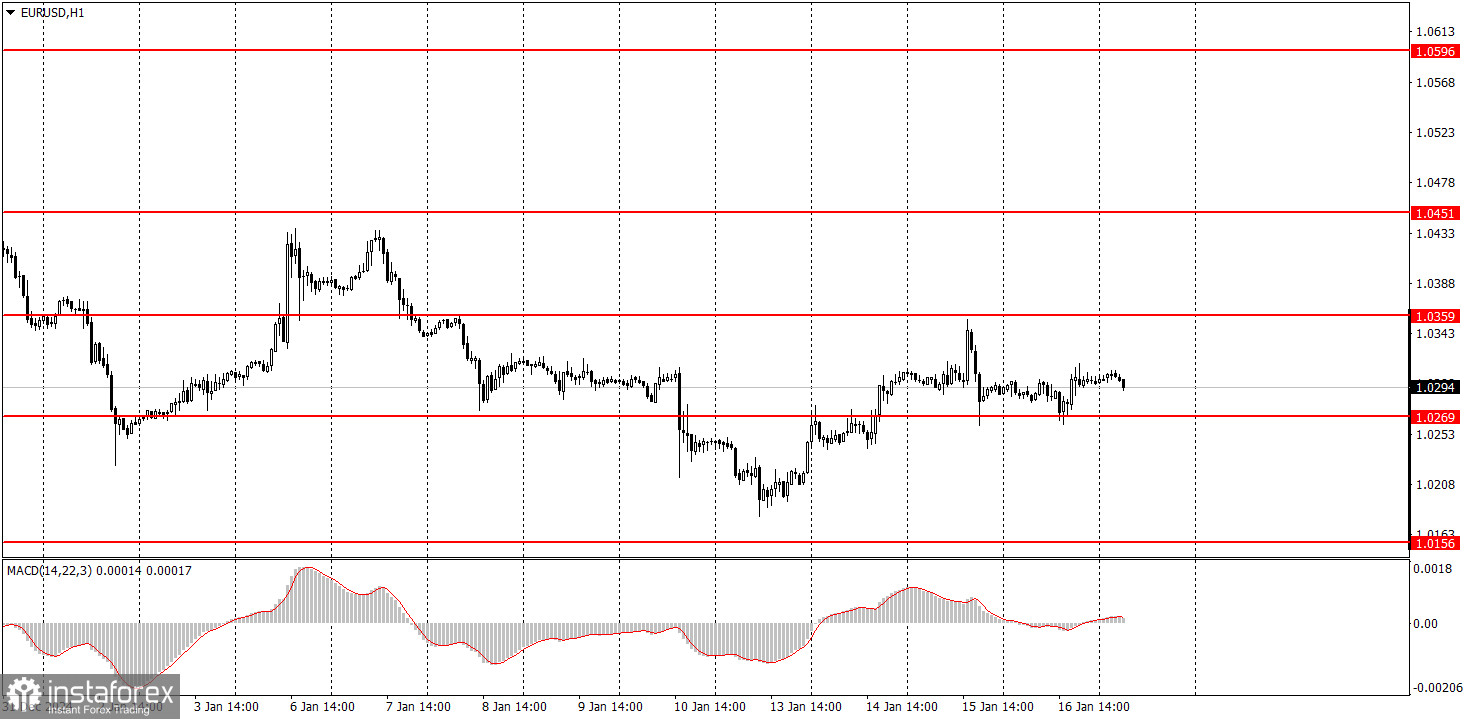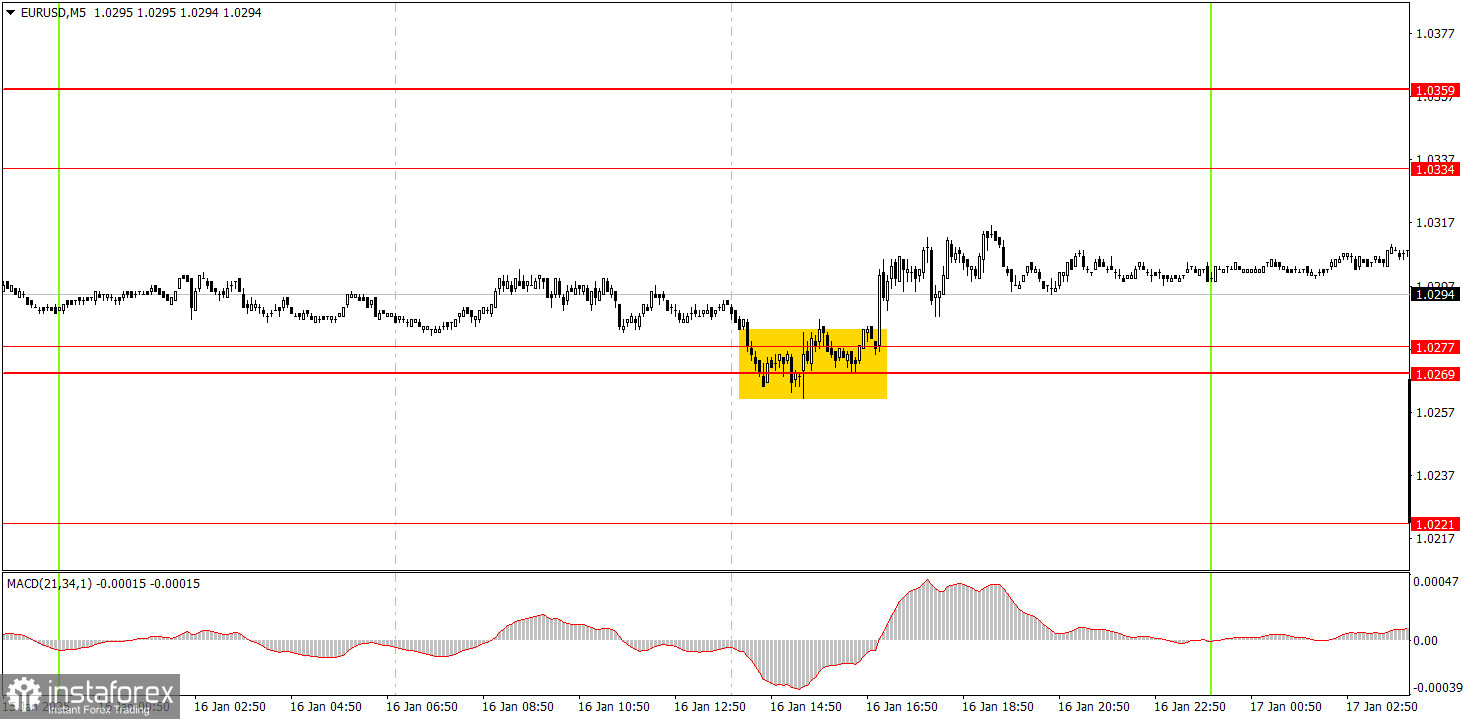Analysis of Thursday's Trades
1H Chart of EUR/USD

On Thursday, the EUR/USD pair experienced low volatility and primarily moved sideways. As we had anticipated, the macroeconomic reports scheduled for the day were not significant enough to provoke major market reactions, and this prediction proved accurate. The price tested the 1.0269 level once again and bounced back from it, but this does not indicate that a new upward correction is imminent.
It's important to note that the data released this week mostly favors the dollar's growth rather than the euro's. The key U.S. inflation report indicated that prices have been rising for the third consecutive month, which reduces the likelihood of the Federal Reserve continuing to ease monetary policy. Therefore, a rate cut by the Fed seems unlikely in the near future, while the European Central Bank appears determined to pursue its easing measures. We believe there is a high probability that the pair will resume its downward movement.
5M Chart of EUR/USD

On the 5-minute timeframe on Thursday, only one buy signal was generated. At the start of the U.S. trading session, the price struggled to bounce off the 1.0269-1.0277 range but managed to make a 30-pip rise. The euro received some minor support from the U.S. retail sales report, which came in slightly worse than expected. However, it's worth noting that the overall trend remains bearish, even on the hourly chart.
Trading Strategy for Friday:
On the hourly chart, the EUR/USD pair is displaying a continued downward trend. We believe that the decline of the euro has resumed in the medium term, and parity is now within close reach. Further declines in the euro are likely, given the persistent support for the U.S. dollar stemming from fundamental and macroeconomic factors.
Movements on Friday are expected to remain muted, with the euro biased toward further decline. We anticipate that the 1.0269-1.0277 range could be breached today.
On the 5-minute timeframe, important levels to watch include 1.0156, 1.0221, 1.0269-1.0277, 1.0334-1.0359, 1.0433-1.0451, 1.0526, 1.0596, 1.0678, 1.0726-1.0733, 1.0797-1.0804, and 1.0845-1.0851. On Friday, the European Union will release its second inflation estimate for December, which is not considered a significant report. In the U.S., reports on building permits and industrial production will also be released. However, these reports are not expected to trigger strong market movements.
Core Trading System Rules:
- Signal Strength: The shorter the time it takes for a signal to form (a rebound or breakout), the stronger the signal.
- False Signals: If two or more trades near a level result in false signals, subsequent signals from that level should be ignored.
- Flat Markets: In flat conditions, pairs may generate many false signals or none at all. It's better to stop trading at the first signs of a flat market.
- Trading Hours: Open trades between the start of the European session and the middle of the US session, then manually close all trades.
- MACD Signals: On the hourly timeframe, trade MACD signals only during periods of good volatility and a clear trend confirmed by trendlines or trend channels.
- Close Levels: If two levels are too close (5–20 pips apart), treat them as a support or resistance zone.
- Stop Loss: Set a Stop Loss to breakeven after the price moves 15 pips in the desired direction.
Key Chart Elements:
Support and Resistance Levels: These are target levels for opening or closing positions and can also serve as points for placing Take Profit orders.
Red Lines: Channels or trendlines indicating the current trend and the preferred direction for trading.
MACD Indicator (14,22,3): A histogram and signal line used as a supplementary source of trading signals.
Important Events and Reports: Found in the economic calendar, these can heavily influence price movements. Exercise caution or exit the market during their release to avoid sharp reversals.
Forex trading beginners should remember that not every trade will be profitable. Developing a clear strategy and practicing proper money management are essential for long-term trading success.





















